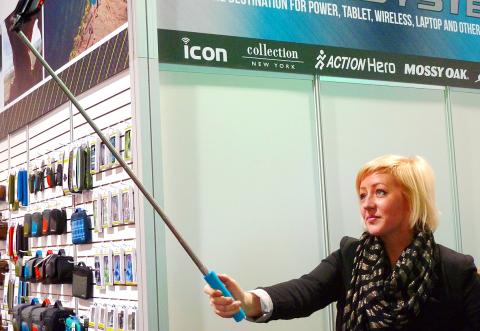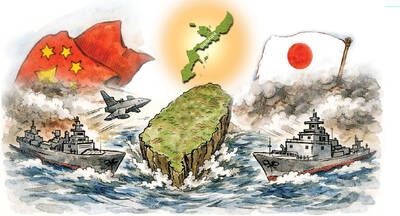“Selfie sticks” — the lightweight monopods which hold smartphones to get a better angle for self portraits — are making the tech community look at things from a new perspective.
These devices became a hot item at this week’s Consumer Electronics Show (CES) in Las Vegas, where dozens of manufacturers and distributors were fielding orders to meet consumer demand.
Priced as low as US$5, the selfie sticks took some of the limelight in a show that features US$10,000 television sets and other pricey hardware.

Photo: AFP/ Rob Leve
“They’re flying off the shelves, they are one of our hottest items,” said Katie Kunsman with the New Jersey-based manufacturer and wholesaler Motion Systems, at her booth at the Las Vegas tech gathering. Kunsman said the trend has taken off in the past few months, led by enthusiasts of extreme sports like rock climbing.
“If you go rock climbing you can get a picture from a good angle hanging off a cliff,” she said.
The origins of the selfie stick are unclear. Some say the trend began in Asia, others point to the extreme sports community and similar devices made for the GoPro camera.
“When I go to a music event, everyone has one,” said Aaron Sanchez at the stand for Mybat, a wholesaler of wireless accessories.
“You can take pictures from different angles that you wouldn’t be able to get otherwise, you can take group selfies. You can get everyone in the picture and you don’t have to ask someone to take it.”
The selfie sticks extend the smartphone camera away from the user by up to about 1.5m, providing a better angle than is possible by simply extending the device at arm’s length.
Some of the gadgets are sold at a very low price, but adding a wireless Bluetooth button to snap pictures can boost the cost to US$30 or US$40 or more.
Sometimes called “narcissticks” because they promote the self-centered picture trend, the devices have faced a ban in South Korea if they use unauthorized radio frequencies.
SELFIES ON CES FLOOR
On the CES show floor, Christina Hutchinson offered visitors a chance to snap a picture to promote “The Selfie Stick” sold by New York-based Lotp Marketing.
Lotp’s Robert Rickheeram said his firm began manufacturing and selling the sticks last year, after his parents bought one in Greece at the same time he found one in China.
“We were one of the first, although I can’t confirm we were the first” to start manufacturing and selling in the US.
“We recognized the trend and we were able to get the Web site theselfiestick.com.”
Rickheeram said it’s not clear if any single company can be dominant in the emerging stick sector.
“Anyone can make these,” he said. “There are no patents, although we have a patent pending.”
He said his device was designed with a strong clamp that holds the smartphone securely in place.
“It has a little more bulk, but we don’t want anyone breaking their US$500 smartphone,” he said.

Most heroes are remembered for the battles they fought. Taiwan’s Black Bat Squadron is remembered for flying into Chinese airspace 838 times between 1953 and 1967, and for the 148 men whose sacrifice bought the intelligence that kept Taiwan secure. Two-thirds of the squadron died carrying out missions most people wouldn’t learn about for another 40 years. The squadron lost 15 aircraft and 148 crew members over those 14 years, making it the deadliest unit in Taiwan’s military history by casualty rate. They flew at night, often at low altitudes, straight into some of the most heavily defended airspace in Asia.

Taiwan’s democracy is at risk. Be very alarmed. This is not a drill. The current constitutional crisis progressed slowly, then suddenly. Political tensions, partisan hostility and emotions are all running high right when cool heads and calm negotiation are most needed. Oxford defines brinkmanship as: “The art or practice of pursuing a dangerous policy to the limits of safety before stopping, especially in politics.” It says the term comes from a quote from a 1956 Cold War interview with then-American Secretary of State John Foster Dulles, when he said: ‘The ability to get to the verge without getting into the war is

Like much in the world today, theater has experienced major disruptions over the six years since COVID-19. The pandemic, the war in Ukraine and social media have created a new normal of geopolitical and information uncertainty, and the performing arts are not immune to these effects. “Ten years ago people wanted to come to the theater to engage with important issues, but now the Internet allows them to engage with those issues powerfully and immediately,” said Faith Tan, programming director of the Esplanade in Singapore, speaking last week in Japan. “One reaction to unpredictability has been a renewed emphasis on

Beijing’s ironic, abusive tantrums aimed at Japan since Japanese Prime Minister Sanae Takaichi publicly stated that a Taiwan contingency would be an existential crisis for Japan, have revealed for all the world to see that the People’s Republic of China (PRC) lusts after Okinawa. We all owe Takaichi a debt of thanks for getting the PRC to make that public. The PRC and its netizens, taking their cue from the Chinese Communist Party (CCP), are presenting Okinawa by mirroring the claims about Taiwan. Official PRC propaganda organs began to wax lyrical about Okinawa’s “unsettled status” beginning last month. A Global